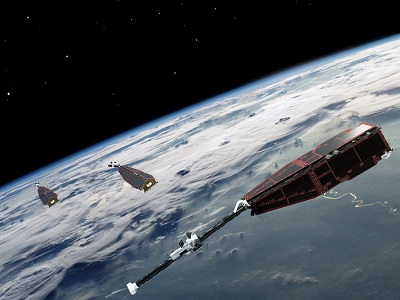- Activities
- 3D mantle conductivity
3D mantle conductivity
Overview
The 3D mantle conductivity project is part of the Swarm DISC (Data, Innovation and Science Cluster).
Understanding the 3D physical properties of the Earth's mantle on a global scale is an outstanding problem of modern geophysics. Only two direct methods can deliver depth-dependent information about the structure of the Earth's mantle: seismic and electromagnetic (EM) sounding methods. In the seismic method, the investigated parameter is seismic velocity, whereas EM retrieves the electrical conductivity. Global seismic tomography provides today a variety of three-dimensional (3D) velocity models; however, the interpretation of the seismic velocity anomalies in thermo-dynamical and compositional parameters is often uncertain, especially when it comes to constraints on hydrogen content. EM sounding methods aim to identify spatial variations of the electrical conductivity in the Earth's interior. Since the conductivity is sensitive to the temperature, chemical composition, and hydrogen content, it helps understand the Earth's origin, past evolution, and modern dynamics.
This project aims to build a global multi-resolution 3D mantle conductivity model for the depth range 0 – 1500 km using a multi-data, multi-source, and multi-response approach. Specifically, the data are time-varying vector magnetic fields obtained from ground-based and satellite observations, the inducing sources are electric currents in the ocean, ionosphere, and magnetosphere, and responses are conventional and novel transfer functions.
Project results are documented regularly through the progress meeting presentations below.
Documentation
Progress Meeting 1 – 10 February 2021
Project duration: September 2020 – March 2023. Project funded by ESA via the Swarm DISC, Contract Change Notice: SW-CN-DTU-GS-036.
References and further readings
- Kuvshinov A, Grayver A, Tøffner-Clausen L, Olsen N (2021), "Probing 3-D electrical conductivity of the mantle using 6 years of Swarm, CryoSat-2 and observatory magnetic data and exploiting matrix Q-responses approach", Earth Planets Space 73 DOI: 10.1186/s40623-020-01341-9
- Grayver AV, Kuvshinov A, Werthmüller D (2021), "Time-domain modeling of 3-D Earth's and planetary electromagnetic induction effect in ground and satellite observations", Journal of Geophysical Research: Space Physics, Vol. 126, e2020JA028672 DOI: 10.1029/2020JA028672
- Chen C, Kruglyakov M, Kuvshinov A (2021), "Advanced three-dimensional electromagnetic modelling using a nested integral equation approach", Geophysical Journal International, Vol. 226, 114–130 DOI: 10.1093/gji/ggab072
- Marshalko E, Kruglyakov M, Kuvshinov A, Juusola L, Kwagala NK, Sokolova E, Pilipenko V (2021), "Comparing three approaches to the inducing source setting for the ground electromagnetic field modeling due to space weather events", Space Weather, Vol. 19, e2020SW002657 DOI: 10.1029/2020SW002657
- Grayver A (2021), "Global 3-D electrical conductivity model of the World Ocean and marine sediments", Geochemistry, Geophysics, Geosystems, 22, e2021GC009950, https://doi.org/10.1029/2021GC009950
- Tasistro-Hart A, Grayver A, Kuvshinov A (2021), "Probabilistic geomagnetic storm forecasting via deep learning", Journal of Geophysical Research: Space Physics, Vol. 126, e2020JA028228 DOI: 10.1029/2020JA028228
- Rigaud R, Kruglyakov M, Kuvshinov A, Pinheiro KJ, Petereit J, Matzka J, Marshalko E (2021), "Exploring effects in tippers at island geomagnetic observatories due to realistic depth- and time-varying oceanic electrical conductivity", Earth Planets Space, Vol. 73, 3 DOI: 10.1186/s40623-020-01339-3
- Mittelholz A, Grayver A, Khan A, Kuvshinov A (2021), "The global conductivity structure of the lunar upper and mid mantle", Journal of Geophysical Research: Planets, 126, e2021JE006980, https://doi.org/10.1029/2021JE006980
- Zenhäusern G, Kuvshinov A, Guzavina M, Maute M (2021), "Towards probing Earth's upper mantle with daily magnetic field variations: exploring a physics based parametrization of the source", Earth, Planets and Space, 73:136, https://doi.org/10.1186/s40623-021-01455-8
